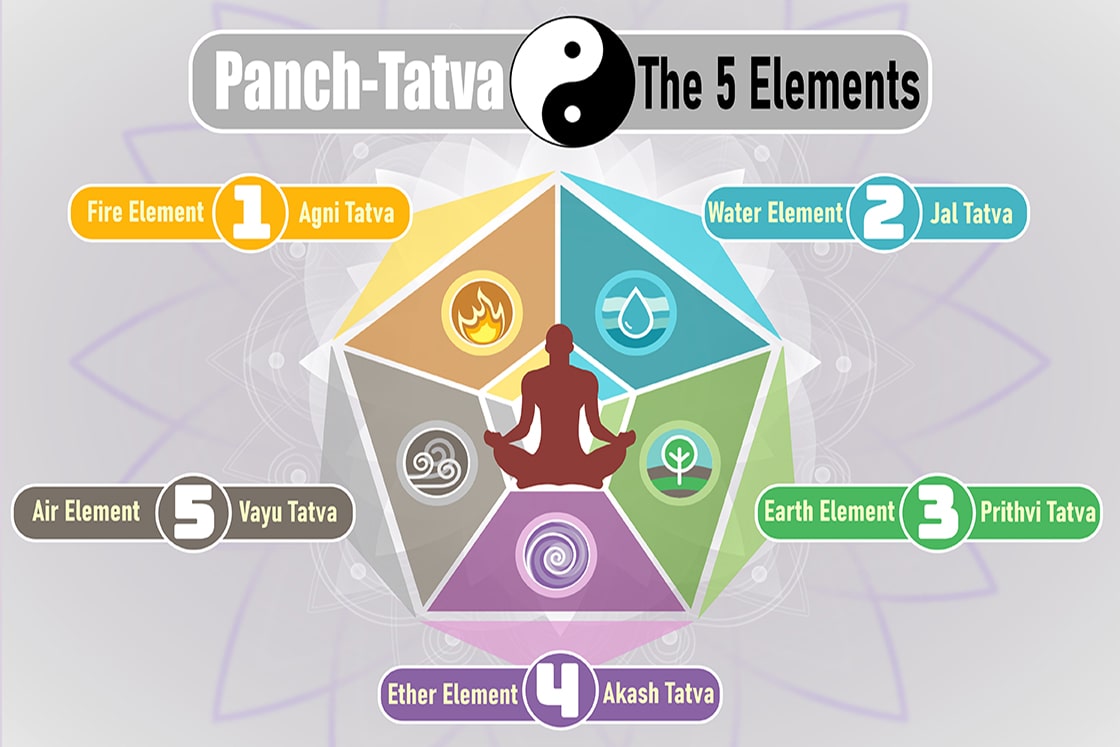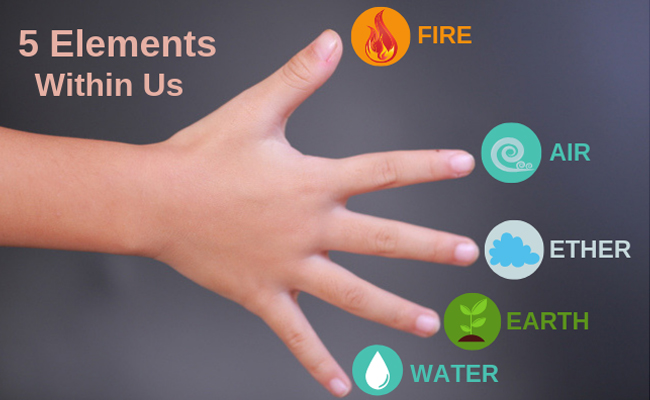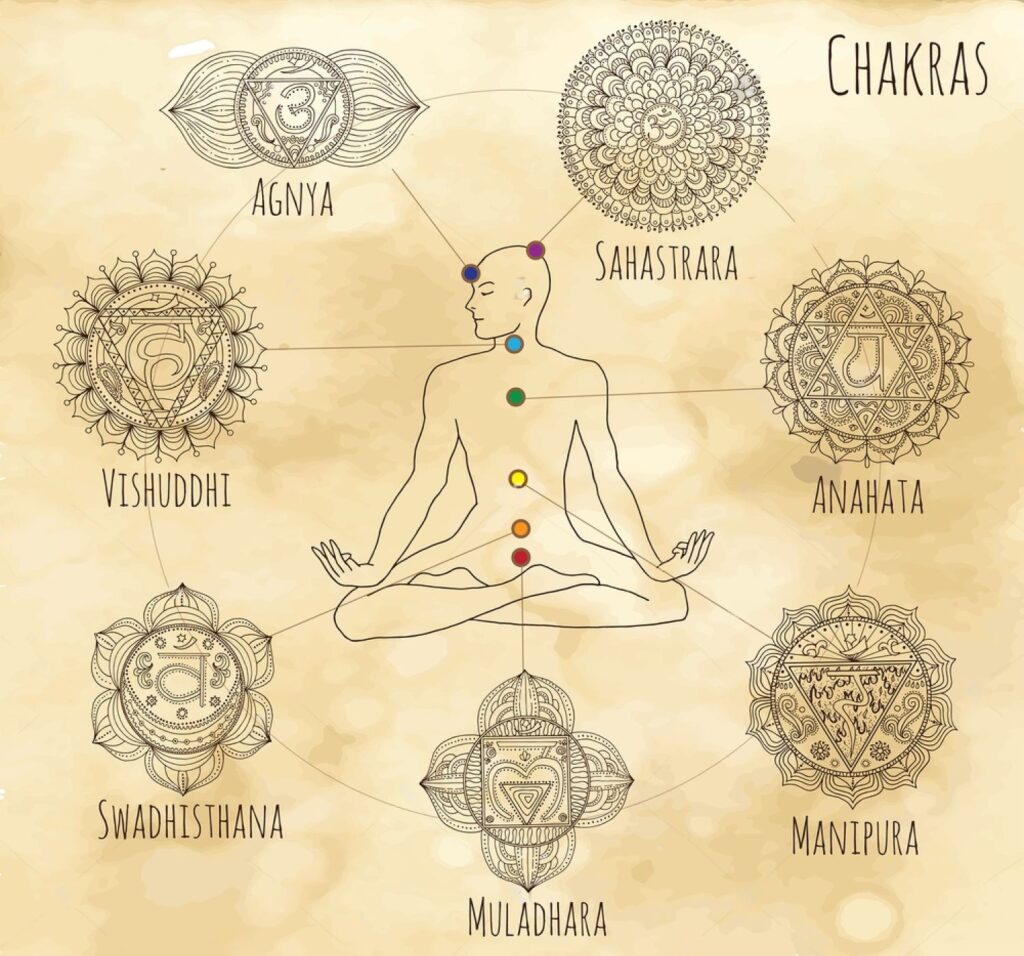
The term “Panch Tatva” frequently appears in ancient scriptures and is integral to many civilizations’ understanding of the universe. It refers to the “five elements” that constitute the universe and our bodies.
According to Hindu mythology, human bodies are created from these five fundamental elements, and upon death, they return to these elements, merging with the ecosystem
Origin of the Word Panch-Tatva
The term ‘Panch Tatva’ originates from Sanskrit, where “panch” means ‘five’ and “tatva” means elements. These five elements, also known as “Panchamahabhutas,” (Pronounced as Pancha maha bho tas) are:
These elements embody physical qualities, energy characteristics, and biological functions. Arranged by density, they are ordered as Earth > Water > Fire > Air > Space.
Pancha-Tatva as the Foundation of the Cosmos

The foundation of the entire cosmos is laid by five cardinal elements. They act like the river bed for this flowing world. All the living and non-living entities of this world are composed of Pancha-tatva or five elements.
The amalgamation of these five elements provides a broad spectrum to each and every object and being in the universe. It not only makes it diverse but also gives it an exceptional dimension.
The proportion and content of the composition in every object and individual might differ but exists in an inseparable form, which is of admixed texture due to the versatility of the different elements.
All the cosmic consciousness and spirit contains these five elements as an integral part of their existence.
Structural Formation of Five Elements
- The origin of air is said to be derived from the ether and it happens to be omnipresent.
- The fire element has its roots in the air and hence it is denser than air.
- Water derives its establishment from fire and has a higher density than fire.
- The highest density amongst all the five elements of the cosmos is found in the Earth. The Earth is said to be derived from water.
Each atom of an element is derived from these Pancha tattvas.
1. Akash – Space Element
Akash tatva is the space that exists beyond the stationary and moving elements of the universe. This space can be occupied by the proton like elements as well as it also allows some neutrons to revolve in it.
2. Vayu – Air Element
It represents the driving force for most of the elements existing in this cosmos. Different Vayus are present in human body in the form of 5 Prana. It is ubiquitous and can provide its force to move the electrons around its nucleus.
3. Agni – Fire Element
It represents the energy that can be transformed into other types of energy.
Every atom has some latent kind of energy present inside. This kind of energy can be released when some atom gets to break down and termed to be exothermic. And when this is energy is taken up by the elements to construct something, it is called endothermic.
.
4. Jal – Water Element
It gives the force which is necessary to attract different parts of an element and keep it together. This kind of process is known as cohesion and water by providing cohesive forces, keep the protons, neutrons, and electrons attracted in the same field.
5. Prithvi – Earth Element
This element provides the matrix to an element. As earth consists and represents the solid-state, it contributes to the same in an element. It results in the structure of electrons, protons, and neutrons of an atom.
The Five Elements and Health
As previously discussed, all animate and inanimate things are made up of these five elements. Therefore, everything that surrounds us, everything we eat, and the biodiversity of the ecosystem are all held together by these Pancha Tattvas.
Natural substances such as foods, plants, herbs, shrubs, sunlight, air, water, and minerals share the same elemental framework as the human body according to the concept of Pancha Tattva. This interconnectedness supports health and connects the body with the environment, keeping the ecosystem balanced.
When these elements are well-proportioned, they lead to a sound and healthy physique. Maintaining equilibrium between the body and nature is essential for a harmonious relationship that promotes better health. Any disharmony in this composition can lead to bodily malfunctions.
The Concept of Indriyas & Panch Tattva
The comprehension of the physical world is done with the help of sense organs or “indriyas”. “Indriyas” are formulated not only by the five sense organs but also by the five organs of action. The five organs of actions are named as vocal cords, hands, feet, genitals, and anus. The five sense organs are eyes, ears, nose, tongue, and skin.
These five sense organs help us to see reality and provide knowledge, they are known as “jnanaindriyas” and the five organs of action help us to perform the functioning, they are known as “karmaindriyas”.
The five lower chakras are related to the Pancha tattva. These chakras namely Sundhistana, Muladhara, Anahata, Vishuddha and Manipura synchronizes with the flow of energy which takes place in the vicinity with the Pancha tattva and associated indriyas.
Five Elements Representing Human Body
The “Earth element” represents bones and muscles. The blood, which is connective tissue and of vital importance, is represented by the “Water element.” The “Air element” initiates breath and respiration. The body’s temperature, i.e., the heat generated and absorbed to maintain homeostasis, is represented by the “Fire element.” The human body, created as a vessel containing a canal where the organs are placed, has its emptiness or hollowness represented by the “Space element.”
The Five Fingers representing the five elements

The constitution of the vital force, or Pran Shakti, lies in the five fingers, with the tips of the fingers being the greatest centers of energy flow. Each finger represents a different component of the five elements, or Mahabhuta.
- Fire (Agni): Thumb
- Air (Vayu): Index finger
- Space (Akash): Middle finger
- Earth (Prithvi): Ring finger
- Water (Jal): Little Finger
The largest element in the Universe is Air. It surrounds the maximum space of the cosmos as well as inside the human body. It fills the cells and intracellular space of the body. Hence, it is represented by the longest finger i.e. the middle finger.
All of these elements are important for the existence and functioning of a body. If any of these elements are removed, it can cause the body to collapse. All the kind of energy present is the basic requirement for carrying out the physiological functions of a body. They are known as Vital force or Pran shakti, e.g. the amalgamation of various forms of energy e.g. electrical, chemical, electromagnetic energy, and bioenergy. The imbalance in these vital forces hampers health.
Human Organs & Chakras Association With Pancha-Tattva

Having an understanding of how five elements of the body are associated with organ systems can lead a person to better health.
1. Akash or Space – Organ of Hearing
The first element is Akash or space and it is related to hearing. The sense of hearing is stimulated by the space element. It corresponds to the mouth as well as ears and hence acts as karmaendriya and jnanaendriya respectively. It has its relation to the Vishuddha chakra.
Also Read: Throat Chakra (Vishuddha) Meaning and How to Balance it
2. Vayu or Air – Organ of Touch
The second element is Air or Wind and it represents motility or movement. It reflects the sense of Sparsh or touch and corresponds to the hands as karmendriya and skin as jnananendriya. The chakra related to the vayu (air) component is the Anahata chakra.
Also Read: Heart Chakra (Anahata): Meaning and How to Balance it
3. Agni or Fire – Organ of Seeing
The third element is agni or fire. It is connected to the flow of energy. It stimulates the sense of sight or seeing i.e. “Rupa”. It is connected to the eyes as Jnanaendriya and karmendriya are represented by the feet. The chakra related to it is Manipura chakra.
Also Read: Solar Plexus Chakra (Manipura): Meaning and How to Balance it
4. Jal or Water – Organ of Taste
The fourth element is Jal or water. water element guides the force of attraction for the existent beings. It stimulates the sense of taste or rasa. The water element is related to the tongue as jnanaendriya and genitals represent the karmaendriya. It is associated with the Swadhisthana chakra.
Also Read: Sacral Chakra (Svadhishthana): Meaning and How to Balance it
5. Prithvi or Earth – Organ of Smell
The fifth element is the Earth or Prithvi or bhumi. This represents the solid matrix of the body. It represents the sense of smell. It corresponds to the nose as jnanaendriya and anus as karmaendriya. The chakra associated with this is the Muladhara chakra.
Also Read: Root Chakra(Muladhara): Meaning and How to Balance it
Many physical ailments can be experienced when there is an imbalance occurs in 5 elements.
Disease Caused by Imbalance of Elements
1. Imbalance of Water element
Water element can have its effects on the blood and its components . It can cause blood thinning or blood clotting. Other effects can be manifested as sinusitis, cold, asthma, the problem during micturition or urination, oedema or swellings and pathology of the reproductive system.
2. Imbalance of Earth element
Due to the imbalance of earth elements, weight-related effects can be seen in the body.
Earth element imbalance might manifest itself as obesity or gain in weight as well as by weight loss. It can cause a disturbed lipid profile by increasing the level of cholesterol. It also results in bones and muscle-related disorders and generalized weakness.
3. Imbalance of Fire element
The imbalance in the fire element leads to disturbed energy flow in and out of the body. It can cause a loss of vital energy.
The gastric fire can also get disrupted by showing the signs and symptoms of acidity. It can lead to diabetes, temperature variation, skin disorders, and mental illness.
4. Imbalance of Air element
An imbalance in air element can cause disorders related to the nervous system. It can affect blood pressure and lungs. It may lead to ataxia, deformities, pain, and depression.
5. Imbalance of Space element
It can cause disorders related to speech. It might lead to diseases in the ear, Thyroid disorders, epilepsy, speech disorders, throat problems, and mental diseases.
Yoga and the Five Elements
As the five elements are also represented by the five fingers, the practice of different yogic mudras (hand postures) can help a person to bring balance among these elements.
The basic posture of Yoga and meditation includes “Mudra” makes energetic connections between nadis or meridians. The way we join our fingers in a mudra is responsible for directing energy and to link it with specific channels to generate particular wavelength energy in the body as well as mind. The inner sense of awareness and awakening can be achieved by joining our hands and unifying the body and mind by regulating posture and breathing.
Magical five fingers
The metabolism of the body can be charismatically affected or regulated with the help of Mudras. Various Mudras affecting health are Vayu Mudra, Akash Mudra, Mritsanjeevani Mudra, Prana Mudra, etc.
How Yoga Helps in Balancing the Five Elements of the Body?
Various forms of Yoga and Pranayama (yogic breathing) helps to balance the five elements of the body.
Asanas which reflect dynamic characteristics of the human body through movement and flow tend to increase Fire in the body. The habit of practicing yoga on a regular basis helps to control the process of deep breathing. It refines the process of respiration and the exchange of gases. The air being the largest element leads to detoxification by cleansing the organs of the body. Its proper regulation through Yoga can be done for the removal of harmful toxins. It purifies all the areas and components by regulating the air-flow across the body.
The poses in Yoga which is based on the mechanism of twisting and energy generation are Paschimottanasana (Sitting forward bend), Ardhmatsyendrasana (Half Spinal Twist), Naukasana (Boat Pose). They are extremely powerful in firing up digestion and maintenance of proper physiological processes. These twists massage the internal and visceral organs and offer detoxification.
The chest-opening poses are concerned with balancing the Air element
- Dhanurasana (Bow Pose)
- Ushtrasana (Camel Pose)
- Bhujangasana (Cobra Pose)
- Chakrasana (Wheel Pose)
- SetuBandhasana (Bridge Pose)
- Natarajasana (Lord of the Dance Pose)
Conclusion
If you learn to regulate the use of breath properly during asana and try to master the art of Pranayama in daily life, you can increase and enhance both calmness and your inner power. It helps you to balance the components of Pancha tattva and channelize the energy in a set and specific direction with the help of different formations of the fingers. The technique of Pranayama can also be used to identify the imbalances hidden in the elements of the body and to bring balance for a healthy life.





A very informative and useful knowledge, at least ds basic knowledge keep one aware of good progressive living of being human.
very useful information.Thank you
Very good info relating the five elements to the human body and how to balance them using Yoga ?
Useful Info, Thanks for your effort & time on this!
Thanks for sharing your knowledge through this article. This should be the basics of our education system.